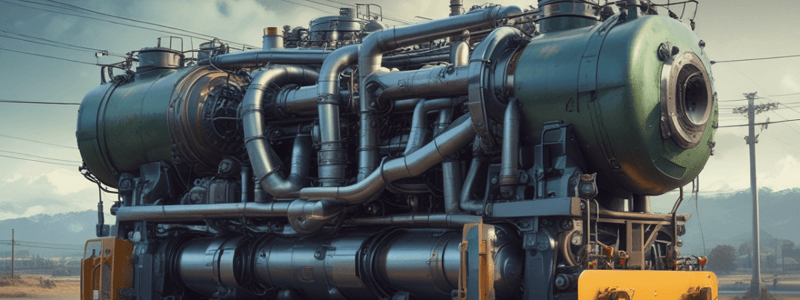Podcast
Questions and Answers
What is the purpose of crankcase ventilation systems?
What is the purpose of crankcase ventilation systems?
- To increase oil leaks in the engine
- To decrease the chance of sulphuric acid forming in the oil (correct)
- To accelerate the mixing of oil and water
- To introduce more combustion gases into the crankcase
Why are combustion gases often referred to as 'blow-by'?
Why are combustion gases often referred to as 'blow-by'?
- Because they mix with fuel in the combustion chamber
- Because they are expelled from the exhaust pipe
- Because they escape past the piston rings into the crankcase (correct)
- Because they are compressed within the cylinder
What would happen if blow-by gases remained in the crankcase?
What would happen if blow-by gases remained in the crankcase?
- Decreased chance of forming sludge
- Enhanced oil lubrication
- Increased chance of oil leaks (correct)
- Improved fuel efficiency
How do water vapours enter the crankcase?
How do water vapours enter the crankcase?
Why is it important to remove combustion gases from the crankcase?
Why is it important to remove combustion gases from the crankcase?
What happens when exhaust gases containing water vapour enter the crankcase?
What happens when exhaust gases containing water vapour enter the crankcase?
What is a potential consequence of the engine operating at low temperature and load?
What is a potential consequence of the engine operating at low temperature and load?
What is the purpose of the crankcase ventilation system?
What is the purpose of the crankcase ventilation system?
Why might oil not reach the crankcase ventilation system in a low operating temperature scenario?
Why might oil not reach the crankcase ventilation system in a low operating temperature scenario?
What can cause increased crankcase pressure and turbocharger seal leakage?
What can cause increased crankcase pressure and turbocharger seal leakage?
What problem is associated with venting the crankcase back into the intake post-2007?
What problem is associated with venting the crankcase back into the intake post-2007?
What is a possible consequence of a plugged fresh air inlet vent/filter?
What is a possible consequence of a plugged fresh air inlet vent/filter?
How does the crankcase ventilation system contribute to extending the service life of engine oil?
How does the crankcase ventilation system contribute to extending the service life of engine oil?
What issue is associated with a bent outlet tube in the crankcase ventilation system?
What issue is associated with a bent outlet tube in the crankcase ventilation system?
Study Notes
Crankcase Ventilation System
- Removes combustion gases and water vapours from the crankcase.
- Maintained by the Heavy Equipment Technician.
System Function
- Combustion gases escape past piston rings and enter the crankcase during normal engine operation.
- These gases are pressurized, especially in turbo-charged engines.
- Oil leaks can occur if crankcase pressure becomes excessive.
- Removes combustion gases, water vapours, oil vapours, and fuel vapours from the crankcase.
- Prevents formation of sulphuric acid in the oil and oil foaming.
System Operation
- Diesel engine crankcase ventilation system is a modified road draft system.
- Consists of an outlet tube and an inlet filter on the valve cover.
- Creates a low-pressure area at the outlet tube, drawing vapours from the crankcase and dispersing them into the atmosphere.
- Fresh air enters the engine through the filter on the valve cover.
System Service
- Condition and operation of the crankcase ventilation system are crucial.
- Excessive crankcase pressure can cause oil leaks, contamination, and sludge buildup.
- Outlet tube can become plugged with dirt and road debris, or bent during vehicle operation.
- Fresh air inlet vent/filter can become plugged with dirt, oil, or sludge.
Positive Crankcase Ventilation (PCV)
- Venting the crankcase back into the intake allows vapours to be burned in the engine.
- Venting unfiltered into the atmosphere is no longer allowed after 2007.
- Can be vented back into the intake on a turbocharged engine, but with contamination issues.
- Solutions include using a pleated depth type filter or a centrifugal action system to separate oil from vapours.
Studying That Suits You
Use AI to generate personalized quizzes and flashcards to suit your learning preferences.
Description
Learn about the purpose of crankcase ventilation systems and the importance of maintaining them in heavy equipment. Explore the removal process of combustion gases and water vapors from the crankcase.


